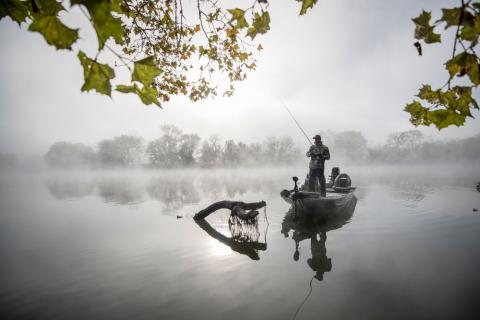Tom Dokken | Originally published in GameKeepers: Farming for Wildlife Magazine. To subscribe, click here.
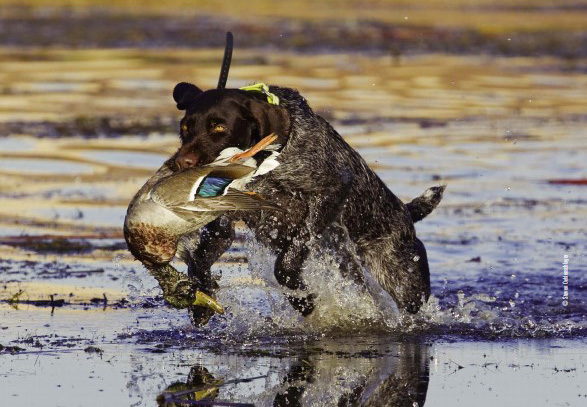
It's a strange thing to think about, but if you really break it down the most ethical way to hunt upland birds and waterfowl is with a good hunting dog. We often focus on the fact that a four-legged hunting partner will greatly increase our chances of killing more birds and that is certainly true, but there is more to it than that. If you’re going to wing-shoot you’re going to experience your bouts with crippled birds that are destined to perish whether you find them or not.
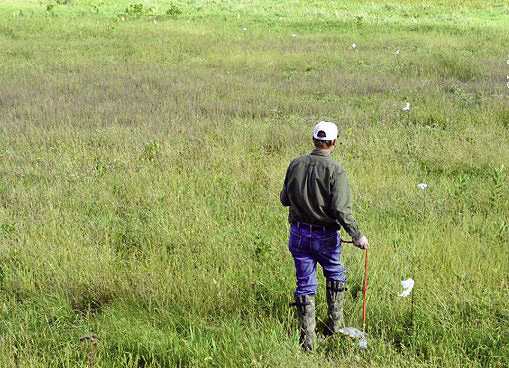
hard to find wounded birds of all species.
It’s the “not” part that we should be concerned with. Although no one wants to lose birds, if you consider the variance of cover we create just to have and hold huntable populations of quail, pheasants or grouse it becomes easy to understand why this should be at the forefront of our minds. Pheasants are notorious for “hitting the ground running” and if there is a bird that’s better at confounding even the most seasoned bird dog, it’s them, especially when you mix a rooster with the type of thick, tangled pheasant-friendly cover they’re associated with. That doesn’t mean quail and grouse are slouches in the wounded disappearing act. A ruffed grouse that has caught the edge of a pattern of six-shot might sail into an alder thicket or cranberry bog, and then it’s a “needle-in-a-haystack” situation where tipping the odds in favor of recovery means sending in a dog comfortable with his nose. Ditto for a bobwhite dropped in a patch of live oak and cactus.
The list doesn’t end there… if you’ve got a pond or stream coursing its way through your land, chances are you’ll tip your eyes skyward in search of fowl of some sort. A bird that hits the water can be trouble. Some birds have a tendency to dive, but many ducks simply swim to shore and hotfoot it to a nearby patch of cover. If you’re sans a dog in this situation, you are in trouble. The same goes for mourning doves carrying, by sheer momentum, an extra 30 or 40 yards after the shot just because of how fast they fly to begin with.
A good bird dog will help you find them; however, a pooch trained specifically for tracking down wounded birds will probably be considered “a great dog”—and rightfully so. Not only do we owe it to the game we hunt, but as responsible land stewards and game managers, it’s our duty to do everything we can to recover wounded birds. If that describes you, consider the following trailing drills to ensure every bird that you shoot ends up on the dinner table.
Pups and First-Timers
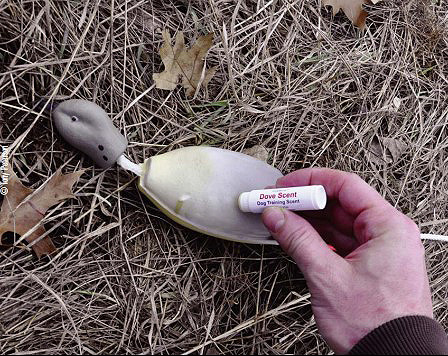
way to get your dog to understand trailing drills. This type of scent
last much longer and adheres to the dummy better under wet
conditions than most liquid scents.
Trailing can start at a very young age for most well-bred bird dogs. It’s an easy process that puppies will take to quickly, but is also something that can be taught to older dogs as well. To start, simply take your dog’s favorite dummy or a real bird wing and do some basic sight retrieves. If you opt for the dummy route, it’s imperative that you do two things. The first is to use a dummy that represents the size and shape of the birds you plan to hunt. The second is to add some bird scent to it that mimics the scent of those same game birds. Most hunters opt for liquid scents because they are readily available but I’ve come to rely much more on wax-based scents. The reason for this is simply because wax-based scents won’t wash or rub off quickly. That’s important at any time, but it becomes very relevant when you consider that the best time of day to conduct these training lessons is when there is some moisture on the grass—early morning or late evening.
In this initial stage of sight retrieves, start in the backyard where things are comfortable and simple. After a few days of this, take your pup to an area with grass tall enough to hide the dummy once you throw it. Make sure once again that the dummy has been “scented up,” so the dog will start using his nose to locate it. If your dog struggles with this step, it’s not ready to start trailing, however, if he has no problems locating the dummy, it’s time to move on.

starting point, release it, and wait 15 minutes before releasing your
dog on the trail.
In short cover, drag a freshly-scented dummy 10 to 15 feet and leave it, making sure that the dog cannot see you doing this. Make a mental note of the exact spot where you started the trail so that you know right where to start the dog. Now, go get the dog and bring him to the spot where you started the drag and use the “hunt dead” command. Pay attention to the wind when you start so that the dog can naturally scent with the wind as it follows the dragline.
If your dog is using his nose correctly, he should immediately look for the dummy in the grass because he can smell the trail. Encourage him to follow the trail the short distance to the dummy while repeating the “hunt dead” command. Once he finds the dummy, offer up plenty of praise or a small treat as encouragement. This may seem like it’s too easy, but that is the point. Good dogs are confident dogs, and a pooch that is unsure of themselves will almost always fail at the moment of truth. He needs to have easy success during the initial stages of this process.
Keep repeating this exercise in multiple locations until it’s apparent the dog understands exactly what he is supposed to do when you give the “hunt dead” command. As with any training situation, remain patient with your pup and don’t give in to the desire to push the dog with longer retrieves just yet because if you do and the dog gets confused, he will start to mistrust that the dummy is there. This is a very common mistake. Make sure he has demonstrated 100-percent success with the 10-to-15-foot drills before moving on.
Nosing Farther
A dog that has mastered the 15-foot retrieve is ready for a 30-footer and another step in the training process. Since it’s very likely that he is also using “your” scent as a guide, it’s a good idea to use knee-high rubber boots and spray them down with scent-eliminating spray. This will force him to key solely on the bird scent when running the trailing drills. After a week or so of conducting 30-foot trailing drills in multiple locations add another 20 yards onto the trail while staying in cover that is just tall enough to hide the dummy
Having successfully completed these longer trailing drills multiple times means that your dog is ready for another change in routine. Deviate from the straight line drags by adding a 45-degree turn to the trail. Leave the dummy 10 to 15 feet from the spot where you angled the trail to make it easier for the dog to find success with this new twist. Don’t be discouraged if your dog gets confused when you institute this step. Remember again to stay patient and encourage him with the “hunt dead” command.
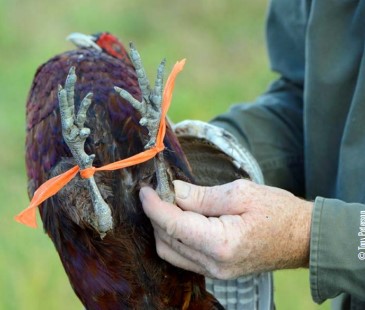
hobble its feet with string so that it can’t run.
After the first 45-degree angle, you can get creative and angle the trail in the opposite direction. It’s highly likely that this will throw your dog for a loop and he’ll search for the trail in the wrong direction. This is exactly what your dog will encounter in the wild when you drop a rooster pheasant or a mallard in the grass. Rarely do they walk in a straight line and your dog needs to learn to backtrack and seek out the trail again if necessary. Staying patient during this phase can be difficult because you will know where the dummy is and it can be hard to watch your dog struggle with finding the right trail and seeing it through.
Unfortunately, it’s the only way he is going to develop the confidence to do this correctly on a real bird. Eventually, your dog should be able to sort out a 150-yard drag with multiple bends in it. How long this takes is dependent totally on individual dogs and the time you put in, but when he gets it, you’ll know. And you’ll be able to move on.
The Next Best Thing
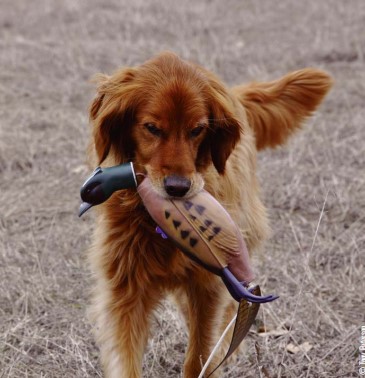
one that represents the game birds you’re most likely
to hunt.
If you have access to pen-raised birds it’s time to introduce them to the process. I prefer mallards, but any live bird will work. Take a clipped-wing bird to a field and put it in the grass and mark the spot where you release the bird. Give it a full 15 minutes to walk around and lay down scent in the grass. After the waiting period is up, release your pup with the “hunt dead” command at the exact release spot. This is as close to the real thing as you are going to get. If you plan to hunt pheasants, try to get clipped-wing pheasants for this step. If that’s the case, it’s a good idea to bind their legs loosely with a bit of string to reduce the length of their stride to prevent them from ending up on the neighbor’s property.
If your dog can sort out this trail he’ll be able to find wounded game birds in the wild; however, you can take the training even further. For example, I like to add a blank gun to my later-stage trailing drills. After firing the gun I’ll tell them to “hunt dead” and watch as they sort out the trail. This is important for developing trust with the dog because in many hunting situations he’ll see the bird fall and know where to start looking. In other situations though, he won’t see a bird fall, but will instead simply hear the shot. In this case, you always want him to trust that you know where the bird is and he should come to you for guidance on where to start his search.
If he gets this and everything else, you’re well upon your way to taking full advantage of your hunting ground and the birds you work so hard to grow and maintain. Plus, you’ll find more enjoyment every time you pull the trigger knowing that you’ve done everything in your power to ensure when the bird hits the ground it will end up snuggled into your game vest.

















